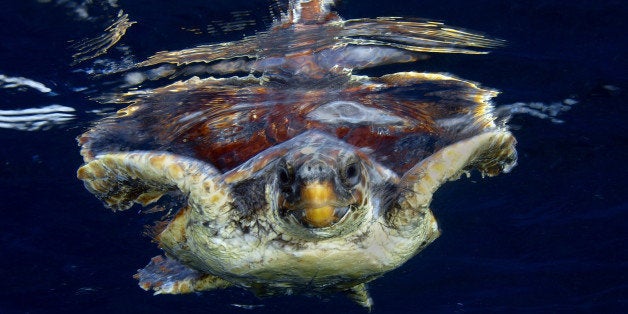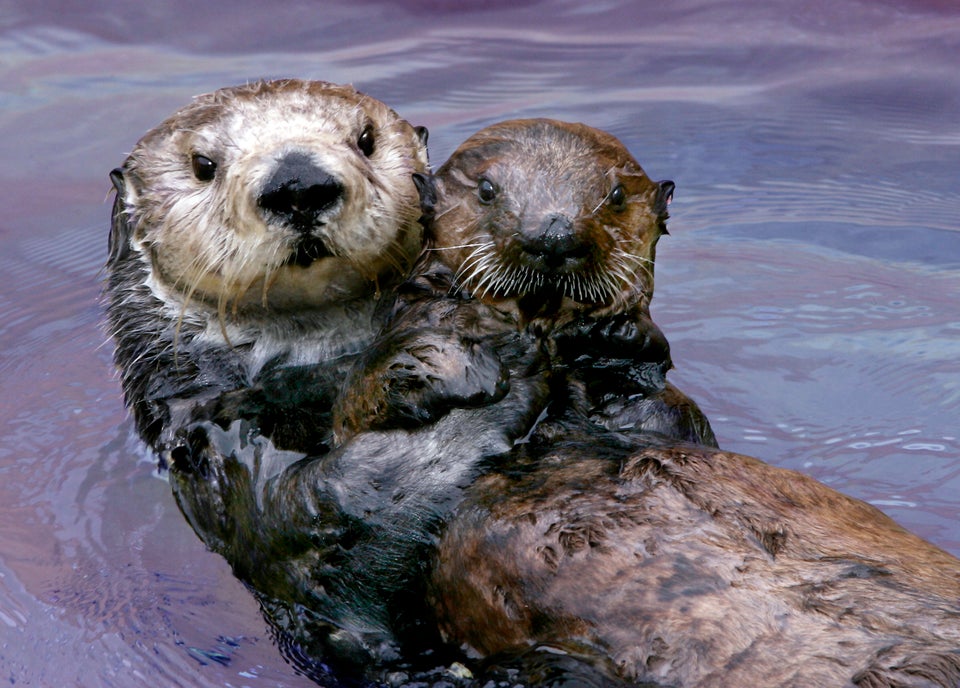
On hatching, loggerhead turtles make a beeline under cover of darkness from nests in the sand to the open ocean. The turtles will return to the same beaches perhaps a decade later, when they have grown 10-fold: born barely bigger than a slice of pepperoni, they arrive the size of a large pizza. The time in between is known to marine biologists as the turtles' "lost years." Exactly how the juveniles spend their time during those years and how they survive has remained a mystery for decades. Now, borrowing a tip from a manicurist, researchers have determined that the turtles do not quite go where they thought and have new clues on how they grow.
This new window into sea turtle behavior comes as a result of scientists conquering a technological question: how to attach satellite tracking tags to very young, fast-growing turtles. A research team based in Florida now has maps of the reptiles' travel on the first long leg of their journey, they reported on March 5 in Proceedings of the Royal Society B.
For loggerheads hatched on Florida beaches, scientists have had some general ideas on their voyage through the Atlantic Ocean. Hatchlings have sometimes been found floating in mats of sargassum seaweed, which they eat and use as shelter. Half-grown specimens have turned up on the Azores, a lonely archipelago about 1,500 kilometers off the Portugal coast, which is over 4,800 kilometers from their Florida birthplace. In other studies researchers have attempted to follow the turtles by swimming behind them for the first few hours of their journey or attaching bulky radio tags that ended up impeding the tiny turtles' movement. "The available technology wasn't there to let us safely track these little turtles," says Kate Mansfield, a marine biologist at the University of Central Florida, but as technology improved, tags got smaller. The model Mansfield's team selected weighs less than a couple of nickels, thanks to a tiny solar panel that replaces heavy batteries. It was developed for birds, and Mansfield thought it might work on young turtles.
The trouble was finding a way to attach the tag. An epoxy called Sonic Weld forms a rock-hard bond and had worked well on adults, but young loggerheads grow so fast that the epoxy mounts warped the shape of their shells after just a few weeks. The team tried harnesses resembling tiny one-piece swimsuits, made of stretchy Lycra. These too warped the turtles' shells, so the researchers designed them with Velcro or dissolvable sutures in hopes that the suits would eventually break away—but in lab tests they never did.
Mansfield and her collaborator Jeanette Wyneken did come up with a flexible attachment that could accommodate the turtles' growth that used a silicone glue and pads made of wetsuit material, but the tags would fall off after a week or two as the turtles shed a thin layer of keratin from their shells. "We realized that turtle shells are the same thing as our fingernails," Mansfield remembers, so they called Wyneken's manicurist (who is named in the acknowledgements of the 2012 paper describing the attachment). She suggested a base coat of acrylic lacquer, which held the tags for months.
After a battery of tests confirming that the tags didn't interfere with turtles' feeding or swimming—and, because they were designed for terrestrial species, also assuring their seaworthiness—Mansfield's team released 17 turtles that ranged from three to nine months old. (The tags still aren't small enough for the youngest hatchlings to wear.) They plopped the turtles into mats of sargassum floating in the Gulf Stream current off Florida, which is part of the North Atlantic Gyre that flows clockwise up the U.S. coast and eventually past the Azores. "Based on long-standing hypotheses, we’d expect that the turtles would remain in the outer gyre currents and head towards the Azores," Mansfield says. "However, a good number of the turtles dropped out of these outer currents and into the center of the gyre and the Sargasso Sea," the area at the center of the gyre where sargassum seaweed accumulates. The turtles also traveled faster than predicted: They reached waters off North Carolina within three weeks and could easily reach the Azores in less than one year. That overall time frame agrees with previous estimates based on passive drifting, but the turtles' speed is impressive, given their many side trips. "They are not traveling simply from point A to point B," Mansfield emphasizes.
What's more, the tags' temperature sensors consistently read several degrees higher than the turtles’ local water temperature. This difference means the seaweed mats may keep these cold-blooded reptiles warm, which in turn helps their growth. Riding the seaweed mats is probably also useful for navigation: In addition to detecting magnetic fields, the turtles can also recognize the scent of mud and thus land.
Bryan Wallace, a marine biologist at the Oceanic Society in California who was not involved in the work, says the study is likely to be remembered as a seminal paper in sea turtle biology. "They don't just stop at putting tracks on maps and showing you where the turtles went,” he says, “but really contextualizing why they go there"—from the big picture of turtles' great migration to the microclimates they find in the seaweed mats. Mansfield's team is now trying to expand their techniques to study other types of sea turtles.
